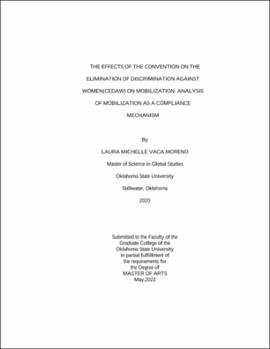| dc.contributor.advisor | Hansen, Holley E. | |
| dc.contributor.author | Vaca Moreno, Laura Michelle | |
| dc.date.accessioned | 2023-08-25T20:06:39Z | |
| dc.date.available | 2023-08-25T20:06:39Z | |
| dc.date.issued | 2023-05 | |
| dc.identifier.uri | https://hdl.handle.net/11244/338974 | |
| dc.description.abstract | Human rights treaty compliance remains an open question in comparative politics literature. There have been treaties like CEDAW, which have achieved remarkable women’s rights improvement. But how this treaty accomplishes this is less clear. Previous research has addressed the results and mechanisms of CEDAW compliance by supporting the rights outcomes on quantitative research and addressing the mechanisms through case studies (Simmons 2009). Other authors have studied the engagement of the party states with the CEDAW committee and the submission of shadow reports as a mechanism for compliance (Algren 2021). In this analysis, I propose to test the theories developed by the case study research – specifically Simmons (2009). I propose that CEDAW compliance follows a two-step process. First, CEDAW ratification activates women’s mobilization at the local level. Then, a stronger women’s movement leverages ratification to enact more domestic change, leading to better treaty compliance. To test my hypotheses, I create a country-year analysis covering the period of 1975 to 2021 in 181 of the 189 countries. As 1979 was the year CEDAW was signed, I go back to 1975 marks the start of my dataset. To identify the countries, I utilize the Varieties of Democracy (V-Dem) database (Coppedge et al. 2021) as the foundation for my dataset. I use the women’s civil society participation index as a proxy for feminist mobilization. | |
| dc.description.abstract | I found evidence to support that, as established in H1, women’s mobilization will become more active in countries that have ratified CEDAW than those that have not. Also, I find support for H2 Countries with strong women’s activism are more likely to comply with CEDAW. | |
| dc.description.abstract | Despite this, I did not find support for the feeding loop between ratification and mobilization. H3 Countries with strong women’s activism, which have also ratified, are more likely to comply with CEDAW. Furthermore, my results question the interactive effects of ratification on women’s rights enhancement. | |
| dc.format | application/pdf | |
| dc.language | en_US | |
| dc.rights | Copyright is held by the author who has granted the Oklahoma State University Library the non-exclusive right to share this material in its institutional repository. Contact Digital Library Services at lib-dls@okstate.edu or 405-744-9161 for the permission policy on the use, reproduction or distribution of this material. | |
| dc.title | Effects of the Convention on the Elimination of Discrimination Against Women (CEDAW) on mobilization: Analysis of mobilization as a compliance mechanism | |
| dc.contributor.committeeMember | Nemeth, Stephen C. | |
| dc.contributor.committeeMember | Herrick, Rebekah | |
| osu.filename | VacaMoreno_okstate_0664M_18157.pdf | |
| osu.accesstype | Open Access | |
| dc.type.genre | Thesis | |
| dc.type.material | Text | |
| dc.subject.keywords | CEDAW | |
| dc.subject.keywords | Convention on the Elimination of Discrimination Against Women | |
| dc.subject.keywords | compliance | |
| dc.subject.keywords | human rights | |
| dc.subject.keywords | mobilization | |
| dc.subject.keywords | ratification | |
| dc.subject.keywords | women's rights | |
| thesis.degree.discipline | Political Science | |
| thesis.degree.grantor | Oklahoma State University | |
